
Porsche 911 GT3 RS: Built for performance, fine-tuned to perfection.
If you thought the 911 GT3 was extreme, wait till you catch wind of the 992 generation 911 GT3 RS. The German car makers have certainly outdone themselves this time round, throwing all their best innovations and technology into one road-going super stead uncompromisingly designed to deliver maximum performance.
But before highlighting what makes the RS variation of the 911 GT3 special, here’s a quick overview of what’s under the hood.
The power comes from a high-revving naturally aspirated 4.0-liter, 6 cylinder engine, producing 518 brake horsepower and topping out at approximately 296 km/h, with an acceleration of 100 km/h in just 3.2 seconds. In comparison, this is just a 15 hp bump over the GT3 model, and in fact, the RS draws 22.5 km/h less on the top end due to extra drag from the wing and bigger width, and a shorter overall gear ratio for the PDK gearbox.
But this slight compromise in raw power is in turn compensated with an immense improvement in handling, enabling the GT3 RS to attack corners at a better and steadier pace with the help of a few tricks up its sleeve.
Well, the first thing you’ll probably notice is the little indicator strip placed snugly between the side-blades of the bodywork…
Just kidding.
Of course, the most prominent feature is the massive swan-neck rear wing that is eye-catchingly unmissable. This is a first-ever Porsche production to fit a two-part dynamic Drag System Reduction (DRS) spoiler, with the upper portion powered by hydraulics to shift its position to either increase or decrease drag depending on the situation.
Essentially, Porsche has integrated a F1-style spoiler into a road car that exploits aerodynamics in clever ways. The movable element is capable of flattening momentarily at the press of a button to reduce drag for that extra spring forward on straight roads. And when rotated to its uppermost vertical angle, the wing doubles as an airbrake to create a deceleration effect that significantly supports the wheel brakes.
But the other notable trait of the GT3 RS is the concept of a central radiator. Every road-going 911 GT3 has 3 radiators at the front whereas the RS model only has one angled radiator under the hood, leveraging on the same success as the RSR and R models.
The downside is that you lose your luggage space and will have to wedge any carry-ons in the roll cage behind you. But on the flipside, this frees up extra margins on both front sides for additional active aero elements to be fitted in the front splitter. These work harmoniously with the continuously adjustable rear wing to create 70% downforce on the rear and 30% downforce on the front.
And to throw in more numbers, this is equivalent to 409 kg total downforce at 200 km/h, twice the amount generated by the 991.2-generation predecessor, and three times more than the current 911 GT3. And at 285 km/h, the total downforce is a whopping 860 kg.
It seems significantly more sensible now that the German engineers forgo a little speed in return for way better handling. At top speeds, the GT3 RS hunkers down on turns as if clicking on rail tracks, bestowing the driver with utmost confidence to make the turn without sacrificing speed unnecessarily.
At this point, it seems obvious that there is one common theme recurring in the RS’s design – Aero.
The new appearance of the 911 GT3 RS is loaded with active aerodynamic elements throughout the supercar. The front spoiler is replaced with a splitter that divides the air to flow over and underneath, with additional vents in the side-blades to divert air outwards. Also, the front wheel arch is fitted with louvre openings, paired with inlets behind the front wheels to reduce dynamic pressure in the wheel arches.
With the large central radiator, it is critical that the hot air be redirected away from the rear engine. And the lips contoured in the nostrils of the front lid does just that, creating an area of low pressure above the radiator to accelerate the hot air sidewards, assisted by fins strategically placed on the roof to further direct the air outwards, ensuring cooler intake temperatures in the rear.
Even the suspension is aero-designed with longer wishbone arms with tear-drop shaped profiles that contribute 40kg to the total downforce of the car.
Speaking of which, the road-going RS adopts a highly intuitive and accessible control that allow drivers to calibrate the drive mode (Normal, Sport and Track) and chassis adjustments via 4 individual rotary controls on the steering wheel. With just a fiddle of the rotary, the rebound and compression damping on the front and rear axles can be adjusted on the fly, even as you roll on the track. Paired with a button for the DRS, the GT3 RS can be truly personalised and fine-tuned to the driver’s preferences.
The 911 GT3 RS is available in the Clubsport and Weissach packages. For no extra cost, the Clubsport package comes with a steel rollover bar, a hand-held fire extinguisher, and more notably, the six-point seatbelts for the driver.
On the other hand, the Weissach package will cost more, but includes a fiercer and sportier touch with the exteriors featuring a carbon-weave finish. It also includes the PDK shift paddles with motorsport-derived magnet technology, enabling gear changes to be even more dynamic thanks to a more precise pressure point and clearly perceptible click.
And on top of that, you’ll have the option to pick between the lightweight forged aluminium wheels, standard, or magnesium forged rims which frees up another 8 kg of weight. You can also choose between the carbon ceramic or steel brakes (which are slightly thicker), but of course, we would suggest the carbon ceramic ones any day.
































